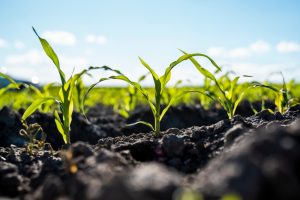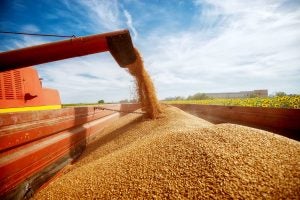Every few days it seems like I pick up a magazine or newspaper article that blames agriculture for 15-, 20-, or even up to 50 percent of the anthropogenic (human) CO2 emissions. Some recognize soil as a significant sink (if crops are grown organically on small farms) but never fail to blame large, monoculture farms that use inorganic fertilizers, pesticides, and, heaven forbid, GMO crops to get maximum yields. No one seems to realize that crops take up and sequester tremendous amounts of CO2 through photosynthesis, incorporating it into plant tissue and seeds, providing food and significant new wealth to the economy.
Michael Pollen in his book, Omnivores Dilemma, claims it takes “about 50 gallons” of crude oil (1.2 barrels) to grow an acre of corn. I can’t argue with that, but he goes on to say it takes a Calorie of fuel energy to produce a Calorie of food, and it’s “too bad we can’t simply drink the petroleum directly.” That is where he is grossly wrong.
(Calories are a familiar unit to most people, but the Calories listed on food packages are actually kilocalories, or 1,000 scientifically defined calories. In the following discussion, I use “Calories” as they are used on a food package. Other energy units, such as BTUs (British Thermal Units) or Joules (units of electrical energy) can be converted to Calories. For example, a gallon of diesel contains approximately 137,000 BTUs or 34,500 Calories.)
In Chapter 4 of my book, World Food Unlimited, I do extensive calculations to represent how much energy is captured by an acre of corn. University of Iowa researchers calculated the energy cost of growing an acre of no-till continuous corn using a gallon of diesel as the energy unit. Manufacturing, mining and distributing the required fertilizer uses 21 gallons. Planting, spraying and harvesting uses 2.5 gallons. Manufacturing a pound of pesticide (active ingredient) requires the equivalent of one gallon of diesel. A no-till farmer may make three pesticide applications of a pound or less, so add three gallons of diesel for pesticide manufacture and distribution. Growing, processing and distributing seed takes a gallon, and allow two gallons for machinery manufacture.
So far we have used 31.5 gallons of diesel to produce 160 bushels of corn. Add in drying costs that can use as much as 0.09 gallons per bushel. That’s a total of 14.4 gallons to dry a 160 bushel crop. Our total is now nearly 46 gallons of diesel energy to grow an acre of no-till corn and safely store it.

The energy in a gallon of crude oil is roughly equivalent to that in a gallon of diesel. A barrel of crude is 42 gallons, so the energy to grow one acre of corn is equivalent to 1.1 barrels of crude. The oil industry says (rule of thumb) it takes one barrel of crude to extract, transport and refine 10 barrels of crude, so we need to add .01 barrel to our total energy cost, making the total crude oil requirement to grow one acre of 160 bushel corn to 1.2 barrels, or 50.4 gallons, or 0.32 gallons per bushel. A barrel of crude oil contains approximately 1,460,000 Calories, and multiplying that figure by 1.2 means growing an acre of corn consumes 1,752,000 Calories, or 10,950 per bushel, or 195 Calories per pound.
Stick with me. The best part is yet to come
Now, how much sun energy did that 1.2 barrels of crude capture? A pound of corn kernels contains 1,550 Calories. There are 56 pounds in a bushel and we have 160 bushels for a total of 8960 pounds. Pounds multiplied by 1,550 gives a total Calorie production from an acre of corn: 13,880,000. Dividing Calories of corn produced by Calories in a barrel of crude oil (1,460,000) equals the equivalent barrels of crude oil captured by sunshine: 9.5!
But wait, there’s more.
It takes a pound of stover (foliage and cobs) to produce a pound of corn, and the stover contains as much energy per pound as the grain, so double the output to 19 barrels. And for every pound of stover, add a quarter pound of roots — another 2.3 barrels of captured energy. The 1.2 barrels of expended energy, then, captured the energy equivalent of a 21.3 barrels of crude oil! Or, in terms of Calories, 1.75 million Calories of oil energy enabled the capture of 31.1 million Calories of energy from photosynthesis, an output-input ratio of 17.8 to 1.
In terms of oil, one thousand acres of no-till corn, genetically modified to use fewer pesticides, will capture 21,300 barrels of oil energy at a cost of 1,200 barrels. In terms of food Calories, one Calorie of oil energy produces 9.5 Calories of food energy (grain only). In addition, 11.8 Calories of refuse energy (roots and stover) is produced to feed the soil biota.
The net energy from the grain, 8.4 barrels (12.3 million Calories) per acre, then enters the economy as new wealth to be exploited by food and manufacturing industries for the benefit of consumers. Applying that energy gain to the 90 million acres American farmers normally grow means a whopping energy input into the economy equal to 756 million barrels of oil. New wealth, sustainably produced, to be used in over 10,000 different products.

The energy in the stover and roots will feed the biota that will release nutrients contained in the stover for future crops. Much of the CO2 in the stover will eventually be returned to the atmosphere because of biota respiration. But about 10 percent of the stover (one-half ton) will eventually be added to the stores of humus in the soil. This doesn’t sound like much, but it is about the same amount that a natural grass prairie would add yearly.
Not all crops are as efficient photosynthesizers as corn. Considering all the worldwide vegetation, crop and non-crop, some authors claim the output-input ratio is 2:1, and when the respiration of biota is taken into consideration, the ratio is close to 1:1. Way too low in my opinion, or else we could not feed and clothe the world and add to the stores of soil carbon as humus.
Jack DeWitt is a farmer-agronomist with farming experience that spans the decades since the end of horse farming to the age of GPS and precision farming. He recounts all and predicts how we can have a future world with abundant food in his book “World Food Unlimited.” A version of this article was republished from Agri-Times Northwest with permission.



